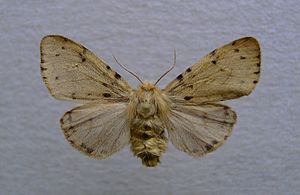Brown spotted bear
| Brown spotted bear | ||||||||||||
|---|---|---|---|---|---|---|---|---|---|---|---|---|

Brown spotted bear ( Diaphora luctuosa ), female |
||||||||||||
| Systematics | ||||||||||||
|
||||||||||||
| Scientific name | ||||||||||||
| Diaphora luctuosa | ||||||||||||
| ( Geyer , 1831) |
The brown Fleckenbär ( Diaphora luctuosa ) is a butterfly ( moth ) from the cutworm - subfamily of tiger moth (Arctiinae).
features
butterfly
The moths have a wingspan of 24 to 29 millimeters for the males and 27 to 35 millimeters for the females. The species is characterized by a slight sexual dimorphism . The wings of the females have a cloudy yellow-brown color, those of the males are darker brown. A few irregularly arranged black spots are distributed over the wing surfaces, which in some specimens form bands that are similar to transverse lines. The speckled pattern is more pronounced on the outer and front edges. The antennae of the males are double combed, those of the females are darkly ringed with only hinted comb teeth. The thorax is furry hairy in both sexes.
Caterpillar
Adult caterpillars are colored black-gray. On the entire length of the body they are provided with black warts from which black-brown tufts of hair protrude.
Similar species
The Alpine Fleckleibbär ( Diaphora sordida ) differs in its stronger coloring and the forewings with fewer black spots and somewhat narrower and thinner scales.
Distribution and occurrence
The distribution area of the brown spotted bear extends from the eastern Alpine valleys over the Balkans to the Black Sea countries . The species prefers to colonize terrain similar to steppes , meadows with little vegetation and mountain slopes.
Way of life
The main flight time of the diurnal, crepuscular and nocturnal moths falls from March to May. The males fly in the sunshine during the day and also visit artificial light sources at night . The females stay in the vegetation and are airborne. The caterpillars feed on the leaves of various low-growing plants. They pupate in a web between leaves or moss.
swell
Individual evidence
- ^ A b Josef J. de Freina, Thomas J. Witt: Noctuoidea, Sphingoidea, Geometroidea, Bombycoidea. In: The Bombyces and Sphinges of the Western Palaearctic. 1st edition. 1, EFW Edition Research & Science, Munich 1987, ISBN 3-926285-00-1 , pp. 154/155
- ↑ Thomas J. Witt, László Ronkay (ed.): Noctuidae Europaeae, Volume 13 , Entomological Press, Sorø, Denmark 2011, ISBN 978-87-89430-18-8 , p. 91
- ↑ Walter Forster , Theodor A. Wohlfahrt : The butterflies of Central Europe. Volume 3: Weirdos and Swarmers. (Bombyces and Sphinges). Franckh'sche Verlagshandlung, Stuttgart 1960, DNB 456642196 , p. 37.
literature
- Thomas J. Witt, László Ronkay (Ed.): Noctuidae Europaeae, Volume 13 , Entomological Press, Sorø, Denmark 2011, ISBN 978-87-89430-18-8 , p. 91
- Josef J. de Freina, Thomas J. Witt: Noctuoidea, Sphingoidea, Geometroidea, Bombycoidea. In: The Bombyces and Sphinges of the Western Palaearctic. 1st edition. 1, EFW Edition Research & Science, Munich 1987, ISBN 3-926285-00-1 , pp. 154/155
Web links
- Lepiforum eV - taxonomy and photos
- leps.it - Moths and Butterflies of Europe and North Africa
- Slovenska-Arctiidae / - caterpillar photos
- www.nic.funet.fi - dissemination
- Diaphora luctuosa in Fauna Europaea. Retrieved November 17, 2016